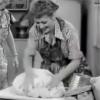
Bread and Bread-Making (1889)
I found this thread on old baking books and have been having fun reading through some of them. "Bread and Bread-Making" by Sarah Rorer had some interesting information and views on baking bread.
Pg.17: She is definitely not a fan of Graham flour or bran classifying it as indigestible.
Pg.26: This chapter titled "Salt Rising" or Emptyings appears to address using wild yeast. She does not have a good opinion of this method of bread baking, mostly insinuating that it is a rather unsanitary method and a cause of indigestion.
Pg.30: In this section discussing baking temperature she believes it necessary to thoroughly kill the yeast in baking and that it isn't sufficiently killed until the internal temperature of the bread reaches past 200°F. If it doesn't reach this temperature, the bread is unwholesome. I also find it interesting that she recommends baking bread at what we would consider quite low temperatures. 280°F for bread cooked in a loaf pan (she calls them "square loaves") and a quick oven at 360°F for breads baked in a shallow French bread pans.
Pg.36: In the chapter titled Diseases of Bread she discusses mold and such, but interestingly she also discusses two different diseases that sounds like rope disease. The first one she blames it on either grain that was in poor condition before milling or the yeast. The second one she doesn't seem to have a reason for it.
The recipes were interesting, though, to me, the crumpets sounded more like english muffins and the english muffins seemed to be more like baked crumpets. And why anyone would want to dip their toast in boiling water is beyond me!


about 30 years old by this time and barely understood by scientists, let along laymen. (Some of the ideas were absolutely terrifying, like cleaning very sensitive parts of the body with carbolic acid)
The fear of these "germs" was intense, creating a craze to clean and sterilize everything that was probably at its peak during the Victorian age.
Good germ, bad germ... kill them all.
of non yeast breads and non sourdough breads. I follow the method for the special starter that Clayton provided in his complete book of bread using corn meal and it makes for one of the most unusual tasting breads we have ever made. There is no reason to add a stinky cheese on top if this one since it sort of smells and tastes like one to me.
https://en.wikipedia.org/wiki/Salt-rising_bread
The how to direct from KA Flour http://www.kingarthurflour.com/blog/2013/11/07/classic-american-salt-rising-bread/